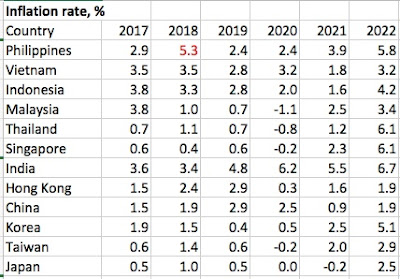A creeping threat to food price stability and food security in many countries is the large-scale conversion of agri land to solar farms, "to save the planet" and in the process fail to save the hungry.
Here is an example, 500 MW solar farm by Solar Philippines by Leandro Legarda-Leviste. Phase 1 is 225 MW (should have been finished this 2023) and Phase 2 is 275 MW. See the photo, it is largely a ricefield to be converted, or already converted, to solar farm.
The old SPNEC leadership should have been ashamed that they posted this photo of wide rice fields to become solar farms. Their contribution to high food inflation is clear. I hope the new SPNEC leadership would put another photo, not showing the rice fields that would no longer contribute in food production in the country.
In Solar Philippines' solar farm in Calatagan, Batangas, they killed many trees to covert to solar farms. The mother, Sen. Loren Legarda, been campaigning for "Plant trees to save the planet." The son, Leandro is silently campaigning for "kill trees to save the planet." And both are rich and powerful. Double talk.

The Ayalas' ACEN is also engaged in agri farm to solar farm. This is their Arayat-Mexico solar farm in Pampanga, 116 MW.
Solar has low capacity factor, recently only about 18%. Meaning a 100 MW solar can actually produce only 18 MW on average, 0 at night and 36 MW daytime.
My latest computation showed that PH solar has capacity factor of only 14%. Why, well it's been often cloudy the past 3 years or more. For instance, from 2021 to 2023, there have been rains all 12 months in a year, including this El Nino 2023 that started last May. It's late December already and always cloudy with occasional rains in Metro Manila and nearby provinces. Solar hates shade -- from trees, clouds and rains.
And solar requires huge land area, average 1.5 hectare per 1 MWp (peak output). So a 100 MWp solar would need 150 hectares. Since that 150 hectares can produce only 18 MW average electricity, then to produce real 100 MW would require about 475 MW installed capacity and about 600 hectares of land. In contrast, a 100 MW coal or gaa plant would need only about 10 hectares, freeing land for Agri, residential or other uses. Solar is about 60x more land intensive than coal and gas. More solar land, more hunger someday.
DUs dilemma
The big private distribution utilities (DUs) in the Philippines are forced to get REs like huge wind solar because of the renewable portfolio standards (RPS) provision of the RE law of 2008 (RA 9513). If they cannot meet the minimum RE share of electricity being distributed to consumers, they will be penalized by the government. So I think the evil here in dangerous land conversion from agri and/or forest use to solar farm is the RE law of 2008. It is coercing, armtwisting the DUs.
Similar to TRAIN law of 2017 (RA 10963), starting 2018 government has imposed diesel tax from 0 to P6/liter by 2020, gasoline from P4 to p10/liter, kerosene, aviation turbo, LPG, etc also affected. Expensive diesel means higher operating cost for tractors, harvesters, irrigation pumps, trucks, fishing boats etc. So higher cost of farming, fishing and their transport is beautiful "to save the planet" according to the TRAIN philosophy, lousy.
One effect, PH has the highest inflation rate in 2018 compared to many Asian neighbors, even other countries around the world. Data from IMF WEO database.
This year, food inflation is the second biggest pull up in overall inflation, after alcoholic beverages and tobacco. Data from the PH Statistics Authority (PSA).
Those stuff of expensive oil, expensive electricity, expensive transportation, expensive food, etc "to save the planet" are lousy and dishonest. The lobbyists and campaigners just want tax tax tax (direct and indirect) from the people by invoking climate. Corrupt.
One long term solution is to abolish the RE law. If people want solar wind, they can have supply contract with many solar wind generators, no need for mandate (mandatory mandatory) by law. Then for people who prefer cheaper food, cheaper electricity, they can get their electricity source from fossil fuel plants like coal and gas. Or from nuke power in the future.
----------------
See also:
Agri Econ 36, High beef, wheat, coffee, ammonia and fertilizer prices, January 21, 2022
Agri Econ 37, Sri Lanka food catastrophe, July 15, 2022
Agri Econ 38, Fermin Adriano article on "Full blown food crisis", September 26, 2022.
 The Ayalas' ACEN is also engaged in agri farm to solar farm. This is their Arayat-Mexico solar farm in Pampanga, 116 MW.
The Ayalas' ACEN is also engaged in agri farm to solar farm. This is their Arayat-Mexico solar farm in Pampanga, 116 MW.



No comments:
Post a Comment